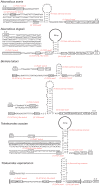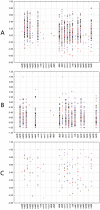New views on strand asymmetry in insect mitochondrial genomes
- PMID: 20856815
- PMCID: PMC2939890
- DOI: 10.1371/journal.pone.0012708
New views on strand asymmetry in insect mitochondrial genomes
Abstract
Strand asymmetry in nucleotide composition is a remarkable feature of animal mitochondrial genomes. Understanding the mutation processes that shape strand asymmetry is essential for comprehensive knowledge of genome evolution, demographical population history and accurate phylogenetic inference. Previous studies found that the relative contributions of different substitution types to strand asymmetry are associated with replication alone or both replication and transcription. However, the relative contributions of replication and transcription to strand asymmetry remain unclear. Here we conducted a broad survey of strand asymmetry across 120 insect mitochondrial genomes, with special reference to the correlation between the signs of skew values and replication orientation/gene direction. The results show that the sign of GC skew on entire mitochondrial genomes is reversed in all species of three distantly related families of insects, Philopteridae (Phthiraptera), Aleyrodidae (Hemiptera) and Braconidae (Hymenoptera); the replication-related elements in the A+T-rich regions of these species are inverted, confirming that reversal of strand asymmetry (GC skew) was caused by inversion of replication origin; and finally, the sign of GC skew value is associated with replication orientation but not with gene direction, while that of AT skew value varies with gene direction, replication and codon positions used in analyses. These findings show that deaminations during replication and other mutations contribute more than selection on amino acid sequences to strand compositions of G and C, and that the replication process has a stronger affect on A and T content than does transcription. Our results may contribute to genome-wide studies of replication and transcription mechanisms.
Conflict of interest statement
Figures




References
-
- Zhang DX, Hewitt GM. Insect mitochondrial control region: a review of its structure, evolution and usefulness in evolutionary studies. Biochemical Systematics and Ecology. 1997;25:99–120.
-
- Ballard JWO, Whitlock MC. The incomplete natural history of mitochondria. Molecular Ecology. 2004;13:729–744. - PubMed
-
- Nikolaou C, Almirantis Y. Deviations from Chargaff's second parity rule in organellar DNA - insights into the evolution of organellar genomes. Gene. 2006;381:34–41. - PubMed
Publication types
MeSH terms
LinkOut - more resources
Full Text Sources
Miscellaneous

